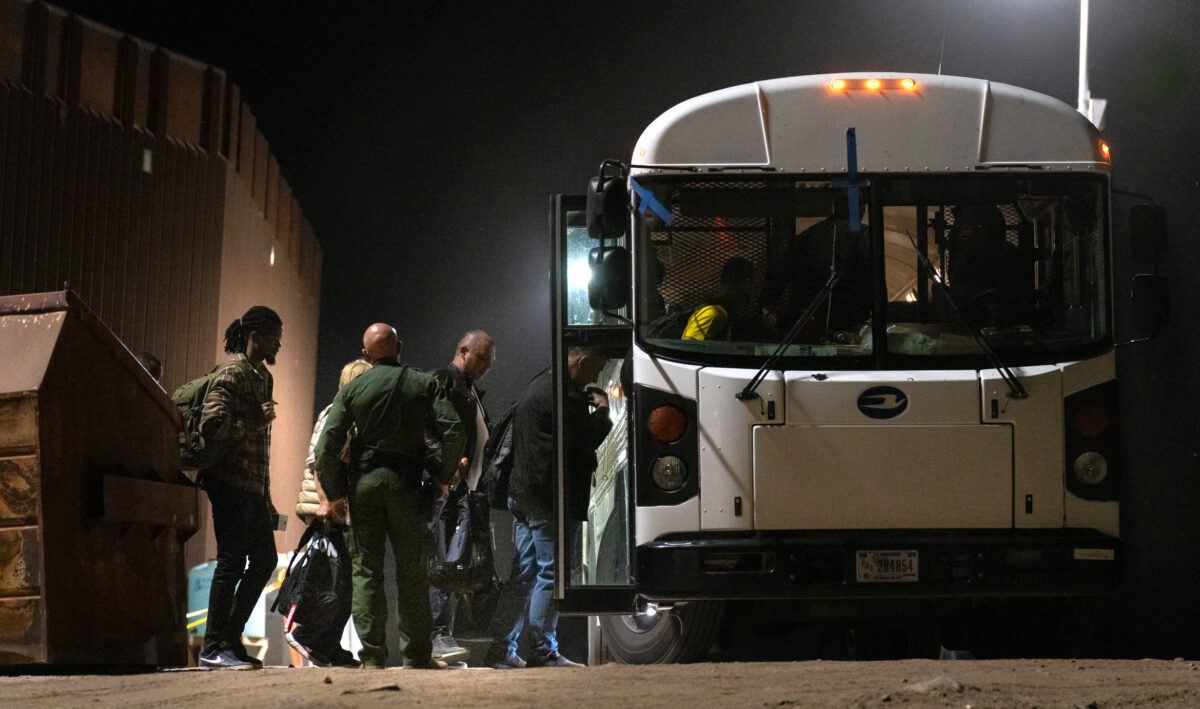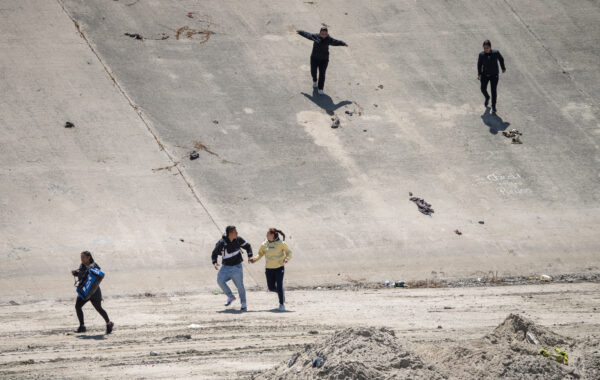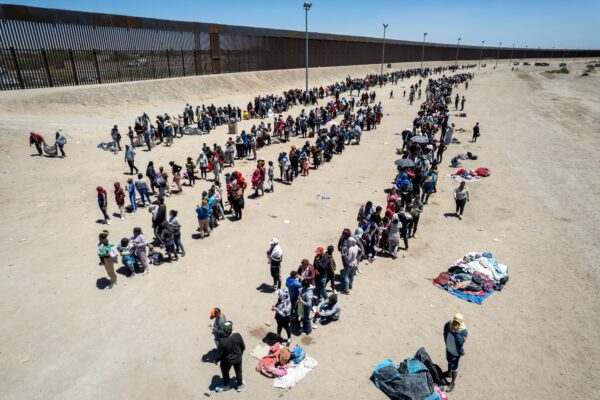


Illegal immigrants are coached to voluntarily withdraw their asylum claims, return to Mexico, and then return to the United States on humanitarian grounds, according to a U.S. Border Patrol union leader.
Manny Bayon, a National Border Patrol Council union spokesman in San Diego, told The Epoch Times on May 26 that migrants who enter the United States illegally in Yuma, Arizona, are being bused to the San Ysidro and Otay Mesa ports of entry in San Diego County. From there, he said, they are returned to Mexico but are allowed to re-enter the United States by applying for “humanitarian parole” via the “CBP One” mobile phone app.
“It’s a backdoor deal,” he said. “The minute they go into Mexico, they turn around at the port of entry, and they’re CBP One.”
Contrary to the Biden administration’s claim that it has implemented more stringent policies—with the expiration of Title 42 and return of Title 8—to deter illegal immigration, the new CBP One process is “circumventing everything,” Bayon said.
Under CBP One, illegal immigrants are encouraged to abandon their asylum claims and instead apply for “humanitarian parole,” he said.
“So, it makes it look like that they’re entering legally,” Bayon said. “Normally, they would go back to their country, but they just turn around and come in through the port of entry, and then [they] are processed that way.”

While it appears “illegal entrant migrants” are being deported to Mexico, they are actually withdrawing their asylum claims, going to Mexico, and then coming back into the United States legally through CBP One, Bayon said.
“It’s pretty much a revolving door” in which the illegal entrants are granted humanitarian parole and “allowed into the country legally,” he said.
“Now they’re legally being processed through the port of entry instead of under Title 8, which would be illegally entering the United States,” Bayon said.
Under Title 8, people who cross the border illegally can be “expeditiously removed” and banned from entering the United States for five years. Those who claim asylum by claiming “credible fear” can either be denied entry or released pending a court hearing. However, only one in 10 illegal immigrants show up for their final hearings to determine whether or not they can remain in the country, and immigration courts are backed up for years.
Entering the country under humanitarian grounds means the illegal immigrants are issued a pass, usually for up to two years before the pass comes up for renewal, Bayon said.

Despite an anticipated rush of tens of thousands of illegal immigrants to the border when Title 42 restrictions were lifted after three years at 11:59 p.m. on May 11, the Department of Homeland Security (DHS) reported a sudden drop in the number of encounters along the southern border.
Homeland Security Secretary Alejandro Mayorkas told news reporters the numbers had dropped by 50 percent to 6,300 border encounters on May 12 and 4,200 on May 13, down from more than 10,000 earlier that week.
According to U.S. Customs and Border Protection (CBP) data, there were 526,901 total Border Patrol enforcement actions in the 2017 fiscal year (Oct. 1 to Sept. 30) compared to 2,766,582 last year, and 1,816,958 so far in 2023.
The sudden drop isn’t because fewer migrants are entering the United States, but that they are technically not crossing illegally under CBP One, Bayon said.
“The numbers are being fudged,” he said. “And, if they’re doing this, that’s not being very truthful to the American public.”
For more than two years, under the Biden administration, people who entered the United States illegally in Arizona under asylum claims have been bused to interior Border Patrol stations such as Indio, Blythe, and Murrieta in California’s Riverside County. From there, they were released daily by the busloads to non-governmental organizations, or NGOs. But, Bayon said, the flow of illegal immigrants to those inland facilities has “dried up” in the last week.
Bayon questions why illegal immigrants who surrendered to Border Patrol in Arizona have suddenly been rerouted to U.S. ports of entry in San Diego County.
“That’s fishy,” he said. “It’s like somebody flipped the switch.”
When pressed about who specifically advised illegal immigrants to abandon their asylum claims and apply for humanitarian parole under CBP One, Bayon replied, “That’s a good question,” but in general, he said, “the government is doing this.”
Bayon said he asked CBP why the buses had stopped going from Yuma to Murrieta, and was told the order came from above.
“They said it’s higher than us. That’s headquarters, so anything above headquarters is probably the Biden administration,” he said.
On March 28, Sen. Josh Hawley (R-Mo.) grilled Homeland Security Secretary Alejandro Mayorkas, calling the CBP One app a “concierge service” and “Ticketmaster” for illegal immigration.
“So rather than building a wall, Mr. Secretary, you have built Ticketmaster for illegal immigrants,” Hawley said at a Senate Judiciary Committee hearing where he called for Mayorkas to resign.
Mayorkas denied the allegations and said Hawley had “mischaracterized” the intent of the program.
Republicans, including Sen. Ted Cruz (R-Texas) and House Speaker Kevin McCarthy, have since called for Mayorkas to step down.
U.S. Customs and Border Protection launched CBP One on Oct. 28, 2020—just days before the presidential election. But, over the last two years, the agency has expanded the use of the mobile app, “making it the only way certain migrants seeking entry into the United States can submit information to CBP prior to their arrival,” according to the American Immigration Council.
About a month ago, the Biden administration granted preferred status to Cubans, Haitians, Venezuelans, and Nicaraguans trying to enter the United States. These people no longer have to claim asylum but are permitted entry under “humanitarian” grounds, Bayon said.
Todd Bensman, a senior fellow on national security at the Center for Immigration Studies (CIS) and author of “Overrun: How Joe Biden unleashed the Greatest Border Crisis in U.S. History,” told The Epoch Times that according to his sources, immigration officials are persuading illegal immigrants to “voluntarily withdraw” their asylum claims without getting a black mark on their records, return to Mexico, and then come back into the United States with humanitarian parole permits under the expanded CBP One app.
Bensman, who worked as a journalist for 23 years and covered the border and illegal immigration issues extensively before joining the CIS think tank, said the Biden administration has turned the Border Patrol into a “welcoming committee” for illegal immigrants.
He dismissed the notion that migrants are risking their lives to come to the United States based on “disinformation” from cartels as Mayorkas claims.
The migrants don’t base their decisions on what the cartels say, but only on information they get from other migrants they trust who’ve successfully made it into the United States, Bensman said.
“That’s it,” he said. “When the administration says the border is closed and everybody is getting turned back, they check to see if the people are actually getting turned back or if they’re being released onto the buses, and then they’re like, ‘They’re lying. Let’s go!’”
In one video at the Matamoros, Mexico, to Brownsville, Texas, border crossing, Bensman asked several people from different countries going through the port of entry how they were getting in legally, and most nodded yes when he asked if they used the CBP One app.
Just before Title 42 expired, as migrants amassed to rush the border and news reporters arrived at the border near the San Ysidro Port of Entry, the Biden administration dodged the national media spotlight by rapidly releasing thousands of illegal immigrants in the San Diego area alone.
“Somebody in the administration—the White House administration—sent the message over to headquarters, DHS, and CBP in Washington, D.C., and they said we need to get those bodies out of there. They’re giving us bad publicity,” Bayon said.
CBP officials called out to San Diego and ordered Border Patrol agents to move the “illegal entrant aliens” out of sight and out of mind, according to Bayon.
“They sent buses, vans, and in a few hours they had all those people taken out of that area,” he said.
Most of the people were taken to detention centers in San Ysidro and Otay Mesa.
“But, once they were in custody, we were so overwhelmed that they decided to send illegal entrant aliens to El Paso, Texas,” Bayon said. “They sent 2,500 to El Paso.”

When the media caught wind that the illegal immigrants were being flown to Texas, they moved news crews to the San Diego airport, but when a bus driver saw the cameras, he turned around and the rest of the buses were sent to the “back executive lot” of the airport normally reserved for overnight mail services such as FedEx, DHL, UPS, and the military, Bayon said.
On May 11, hundreds more illegal immigrants were released to NGOs in San Diego, he said.
Last week, another 300 migrants crossed illegally into the United States at Imperial Beach, about a quarter-mile west of the San Ysidro port of entry. They were detected on infrared cameras entering through a hole in the fencing Mexican drug cartels had carved out, according to Bayon.
“Within an hour-and-a-half, there were buses down there and vans to get the illegal entrant aliens out,” he said.
